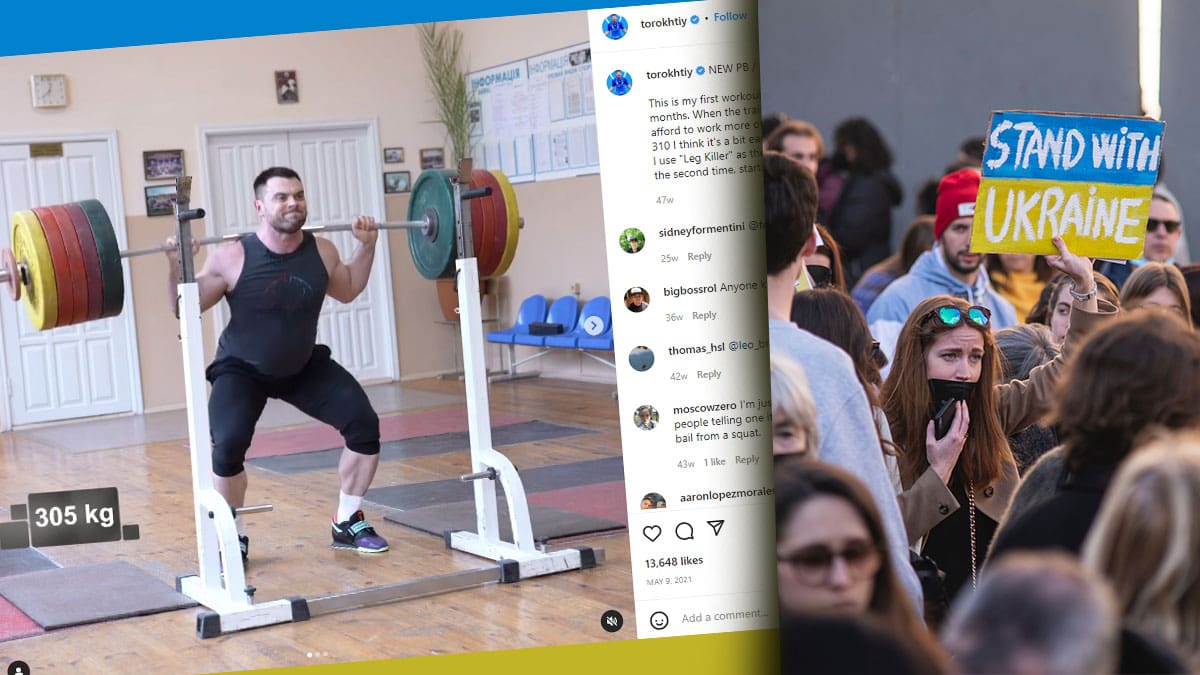These great tips from Oleksiy Torokhtiy will teach you how to set new Squat PBs.
A Ukranian lifter that has competed on the Olympic stage, he will explain what personally works for him, and how you can apply that to your own training.
As the ongoing Russian invasion continues, we ask you to support Ukranian companies and check out his wesbite and training programs.
Over to Oleksiy…
The development of power and strength in almost all sports is associated with knee and hip extension, which is why Squats are an integral part of any strength training.
How to Set New Squat PBs
Depending on the stage and goals of training, your coach can set different purposes for the athlete, from the maximum weight to the maximum number of reps with weight equal to his body weight.
In this article, we will discuss How to Set a New Squat Personal Best.
There is a saying among weightlifters and powerlifters: “Descending with a heavy barbell is easy, but recovery is way more difficult.”
Therefore, keep my TOP 5 tips in mind. They will help you not only get down, but also stand up again with a barbell, and progress in Back Squat as a result.
How to Set Squat PBs – Training Tips
TIP #1: Control the Movement
Doing the Back Squat, up to 80% of your 1 RM, try to perform the descending phase slowly and explode back up quickly and with great power.
If you find it difficult to control yourself, I recommend that you try counting as follows during the lowering:
Count of 3-4 seconds with weight up to 50%;
Count of 2-3 seconds with a weight of 50 to 80%;
Count of 2 seconds for weights from 80% and upwards.
Why is it important?
– This will help to control of the center of gravity and optimise biomechanics. By descending slowly, you will always have less chance of making a mistake.
– You create additional muscle work in the eccentric mode. By descending slowly, you increase the time under tension (TUT), which means you train the muscles when you are moving both down and up.
TIP #2: Add Front Squat into your Training
By practicing Front Squat at least once a week, you will develop leg strength and develop your back, abdomen and core strength.
What is important here is that you establish a reliable and safe hold on the barbell as it rests on the shoulders.
Many athletes believe that Front Squats are the same as Back Squats, but they have different biomechanics.
Generally, if you don’t have mobility issues, you should be able to Front Squat 70-80% of your best result in Back Squat, but it’s not necessary to go so high and working in a 50-60% zone will be enough, if you have never tried it before.
Why is it Important?
– Body stability training will allow you to perform squats without disturbing the spinal position.
– In the front squat, the muscles of the legs and back work in slightly different “angles”. This increases the variability of the workout, which also improves the result.
TIP #3: Pause Back Squat
Adding a 2-second pause to your squats will make your back squat more reliable in the bottom position.
I recommend doing Paused Back Squat no more than once a week, starting with light weights and working your way up to medium and/or above average.
It is important to squat to the maximum depth and stretch the leg muscles as much as possible, but at the same time maintain good position with the torso (NO butt wink).
Why is it Important?
– This will allow the body to build a stability in the bottom position.
– It will developing the starting force necessary for effective switching from the eccentric mode to the overcoming one.
TIP #4: Lifting Shoes & Belt
Weightlifting shoes are recommended as they will help you squat deeper.
They make it more comfortable and balanced, especially if you have limited ankle mobility.
This problem is very common among beginner and intermediate athletes. The firm sole and lacing/strapping systems will give you more stability when working with the barbell.
As for the belt, from my experience, I would say that this is not necessary. And even if you are already using a lifting belt, I recommend wearing it at 70% or higher to keep your muscles in good shape.
TIP #5: Solid Training Program
Remember that a new result will take time and, most importantly, consistency.
Without consistency, everything that was described in the previous 4 topics will not make sense.
If you want to add new kilos to your squat, from my experience, I would advise:
– give yourself at least 5 weeks of training if you were already in good shape
– 9 weeks or more if you have had a break or have returned from vacation and are just starting your training again.
The number of workouts:
Minimum – 3 times a week
Optimal – 5 times a week
You can download my solid Leg Killer program here.
In conclusion, a few “secret” champion tips for quality progress:
The best way to be successful is by working together as a team!
Try to organize a team of 3 like-minded people who all commit to reaching their goals. The rivalry will motivate you not to miss training and make sure you hit every session at 101%.
And don’t forget to keep a Warm Body & Cold Mind!
Image Sources
- Squat-PB: Torokhity / Edoardo Ceriani on Unsplash
